
Heads up! SEO sprints are a powerful strategy that delivered impressive results for 72% of marketers in just 12 weeks.
In the digital marketing world dominated by Google, mastering SEO requires a mix of technical skills, creativity, and effective communication.
If you manage an SEO team, SEO sprints can be your secret weapon. This blog explains how they can enhance your SEO efforts, bringing order, efficiency, and increased profits. No more guesswork – it provides a system that runs smoothly.
Ready to replace chaos with organized success in SEO?
Let’s delve into SEO sprints and transform your SEO journey!
SEO Sprints: Why They Matter for Online Success?

Picture your business strategy as the captain steering the ship, and SEO sprints as the crew working together to reach the top of Google’s results. It’s all about teamwork, aligning SEO actions with your marketing campaign for a powerful online presence in the right places at the right times.
Understanding Sprints
Before diving into SEO Sprints, let’s understand what sprints are all about.
Sprints in project management are like focused work sprints in a race.
- A sprint is a short, fixed timeframe in which a scrum team tackles a specific amount of work.
- It’s a core element in scrum and agile methods, ensuring teams efficiently deliver high-quality software in a concentrated effort.
In essence, it’s a structured way to get work done swiftly and effectively within a set period, enhancing productivity for agile teams.
While many link scrum sprints to agile software development, they’re not synonymous.
In simpler terms, agile provides the principles, and scrum is the structured method for turning those principles into actionable results. They’re partners, not twins.
How Sprint Workflow and Process Related to SEO?
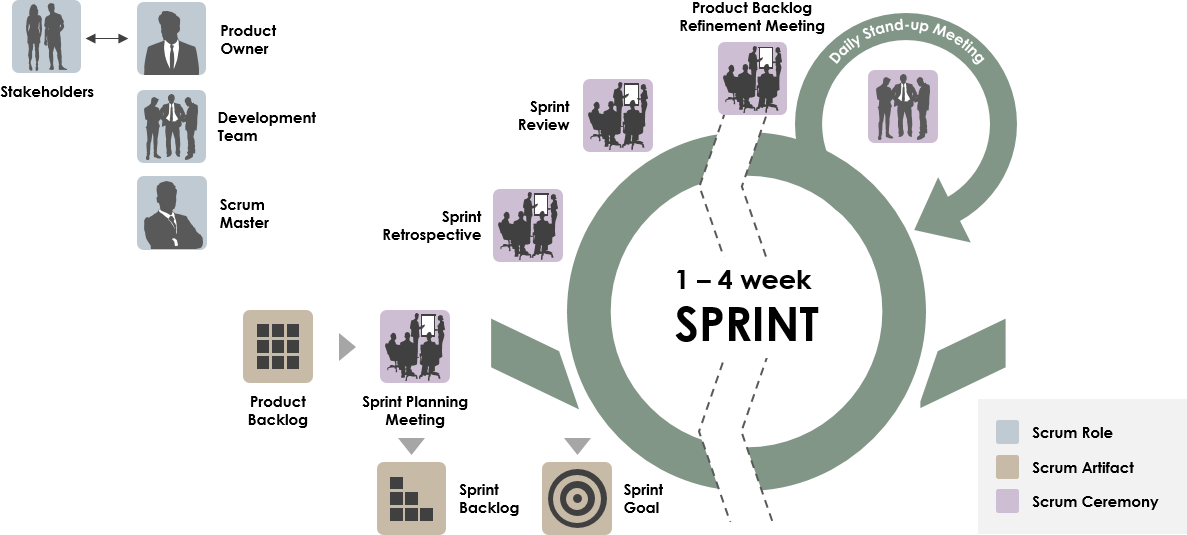
In the Sprint workflow, teams navigate a meticulous process from Backlog Overview to Sprint Allocation. This iterative approach, with a focus on efficient planning and execution, mirrors the ongoing nature of SEO strategies.
Just as teams refine their Sprint planning over time, SEO success demands continuous analysis and adaptation.
The ability to prioritize tasks, set goals, and allocate resources aligns seamlessly with optimizing websites for search engines.
SEO, like Sprint planning, is an ever-evolving journey where refining strategies leads to long-term success in attracting organic traffic and achieving online visibility. That’s where SEO Sprints play a vital role.
What is SEO Sprints?

SEO sprints involve dedicating all resources to optimizing a website for a specific keyword or phrase within a short period of time, typically a couple of weeks.
They’re all about putting all your effort into making a website better for a particular keyword or phrase in a short time, usually a couple of weeks.
This method helps focus on the job and work intensely to boost the website’s rankings on search engines fast. As the competition gets tougher and search engine rules change, SEO professionals need to be smart about their strategies.
SEO sprints offer a methodical and effective way to get quicker results in the competitive world of SEO.
Optimizing SEO Sprints: Simplified Steps

After gaining a thorough understanding of sprint mechanics, you can enhance efficiency by incorporating SEO Sprint model into your processes.
1. Keyword Backlog:
Start by creating a list of keywords relevant to your SEO goals. These could be terms of the target audience is likely to use in search.
Prioritize these keywords based on their importance for the client’s business or content.
How to Find Keyword Backlog?
- Search Volume: Prioritize higher volumes for potential traffic.
- Keyword Difficulty: Use tools (e.g., Ahrefs, Semrush) for acceptable difficulty.

- Relevance to Audience: Align keywords with the type of business and audience.
- Search Intent: Meet searcher expectations for effective results.
- SEO Tools: Utilize tools like Google Keyword Planner for insights.
2. SEO Planning:
Initiate a discussion about the key SEO tasks that need attention. Identify areas of improvement for your website’s visibility on search engines. Decide on the SEO tasks that can realistically be achieved during the sprint duration.
3. SEO Backlog:
Finalize the list of SEO tasks that the team agrees to work on during the sprint. Ensure that everyone in the team is aligned with the chosen SEO tasks.
4. SEO Sprint:
This is the actual implementation phase where the team actively works on executing the SEO tasks outlined in the backlog. The sprint typically lasts for a specific timeframe, often around 30 days.
5. Daily SEO Scrum:
Conduct short daily meetings, led by the SEO specialist, to keep everyone in the loop. Discuss what SEO tasks have been completed, what’s currently in progress, and address any challenges or roadblocks.
6. SEO Outcome:
The expected outcome is an improvement in SEO metrics such as increased visibility, higher rankings, or enhanced site performance. Evaluate whether the implemented changes align with the goals and if further adjustments are needed.
7. Sprint End:
- SEO Review: Examine the impact of the implemented SEO strategies during the sprint.
- SEO Retrospective: Reflect on the sprint’s SEO performance, discuss what worked well, and identify areas for improvement.
Continuous enhancement is crucial for sustained SEO success, and the insights gained contribute to refining future SEO strategies.
Secrets of the Pros in SEO Sprints
Embarking on the journey of an SEO sprint requires a strategic approach that aligns with your client’s unique objectives:
1. Goal Setting Mastery

Setting clear goals is crucial in SEO. Customize objectives for each client and SEO sprint.
- Are you aiming for the top rank for a specific keyword, or is maximum organic traffic your priority?
- Is it a short-term traffic boost or a focus on sustainable, long-term outcomes?
There’s no one-size-fits-all; articulate and pursue your goals with determination.
2. Strategic Analysis Precision

In the SEO sprints journey, strategic analysis takes the spotlight. Success hinges on a focused strategy with quick results.
Dive into crucial factors, giving extra attention to keyword research using tools like Semrush, Google Keyword Plenner, Ahrefs, and Moz Keyword Explorer.
Choosing the right keywords is crucial for SEO success. Consider how relevant and popular they are, but the most important thing is the competition.
Avoid tough battles; go for keywords with less competition. Make sure everything aligns for the best results quickly. Focus on keywords that can give meaningful outcomes in a week or two – time matters a lot.
3. Unlocking User Behavior Insights

To really nail it for your clients, it’s not just about looking at how many people are searching for certain words or how tough the competition is. You’ve got to check out how people act online, too. It’s like the secret sauce.
Different searches mean different behaviors.
To understand more, let’s dive into examples:
- “What is SEO software” vs. “best automated seo software“:
- The person curious about “What is SEO software” is just starting to explore the SEO world.
- On the other hand, the one searching for the “best automated seo software” is likely in the market for some tools, possibly ready to purchase.
2. “Difference between on-page and off-page SEO” vs. “top 5 on page and off-page seo services“:
- The person exploring the difference between on-page and off-page SEO is in the learning phase.
- Meanwhile, the one looking for”top 5 on page and off-page seo services” is likely ready to purchase a service and deepen their knowledge.
3. “Learn to play guitar” vs. “best acoustic guitars 2022”:
- The first person is in learning mode, not necessarily ready to buy a guitar just yet.
- The second person? They’re probably researching to make a purchase decision soon.
Understanding these search behavior differences helps tailor your SEO strategy. It’s like having a conversation – you respond differently to “Tell me more” than to “Where can I get it?”.
Don’t stress about only using keywords that lead to quick purchases. But you and your client need to get what people are likely to do in each situation. It’s like having a game plan for every move they might make.
4. Core Work Excellence

In an SEO sprint, both on-page and off-page seo services are crucial, much like a regular marketing campaign. The tasks mirror typical SEO work, such as creating content, building links, crafting new pages, repurposing old ones, and publishing advertorials.
The key difference lies in precision – you’re zeroing in on one keyword, aiming for the highest ranking within a set timeframe. Quality takes precedence due to the tight parameters.
5. Optimization Tactics for Impact

Optimize the main page for click-throughs and user behavior. Utilize attention-grabbing headlines, special offers, and layout tweaks to enhance conversions and overall SEO sprint impact.
6. Data-Driven Measurement and Reflection

At the end of your SEO sprint, it’s time to measure and reflect on your results: check the final ranking, organic traffic, conversions, and overall ROI.
This data not only showcases your value as an SEO agency to clients but also opens the door for future collaborations. It’s a chance for self-analysis too.
Did you meet your goals? Identify what worked best (and what didn’t), learning from the experience. Use these insights to refine your approach for future SEO sprints, ensuring continual improvement in your capabilities. Every positive change is a step forward in mastering SEO sprints.
How to Track SEO Sprints Outcomes?
1. Organic Traffic
SEO performance is essentially a measure of how effectively a website ranks on search engines, such as Google, and draws in organic traffic. While tracking organic traffic is a key metric—representing visits originating from search engines without ad clicks—there are additional valuable methods to gauge SEO outcomes.
Google Search Console provides an accurate depiction of organic traffic through its “Search Results” report under the “Performance” section.
This report offers insights into how well webpages rank for pertinent keywords and the quality of traffic received.
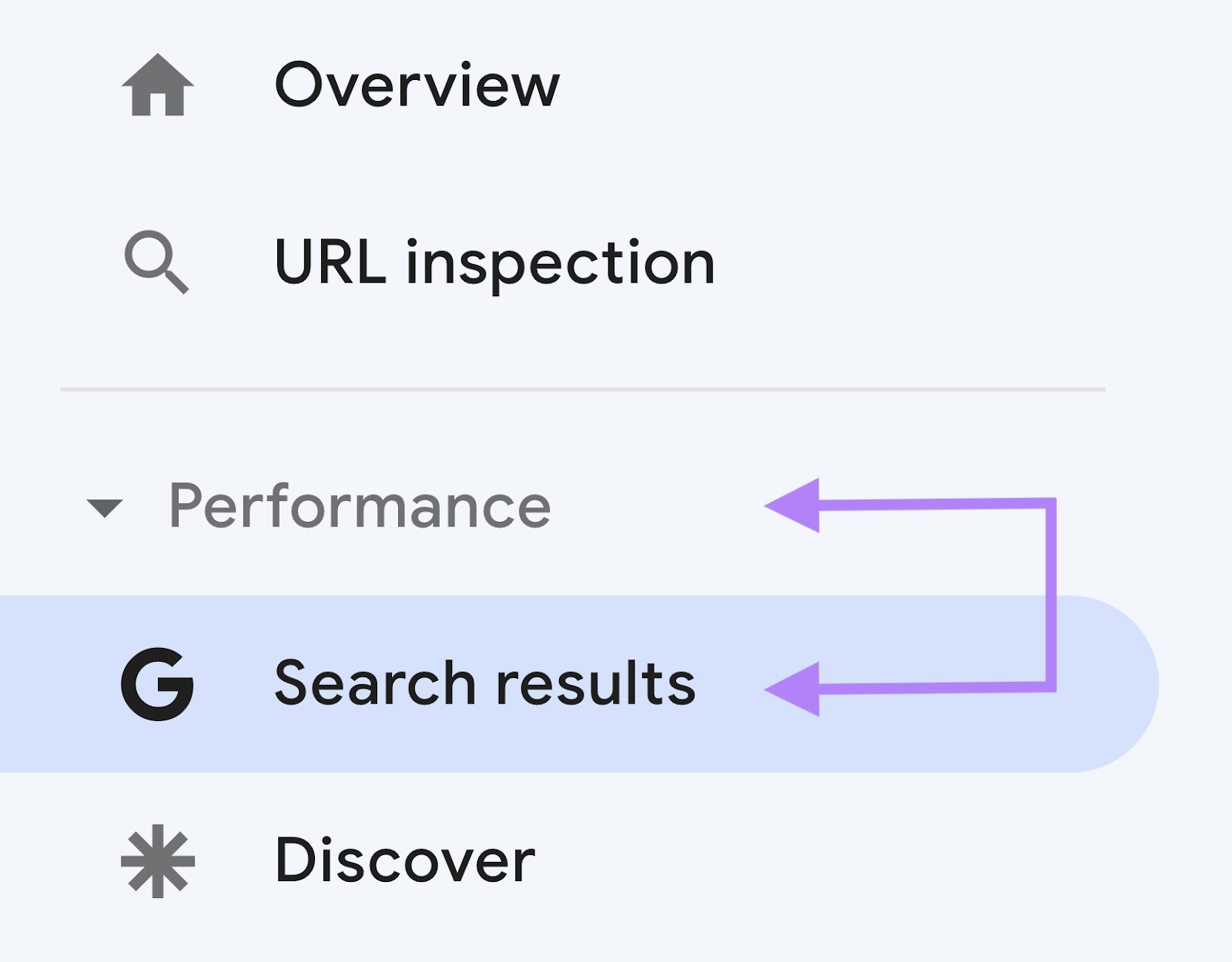
Next, compare the site with competitors to assess strengths, weaknesses, and areas for improvement. Utilize tools like Traffic Analytics for a comprehensive analysis. Simply input the URL and click “Analyze” to gain valuable insights into the site’s performance relative to competitors.
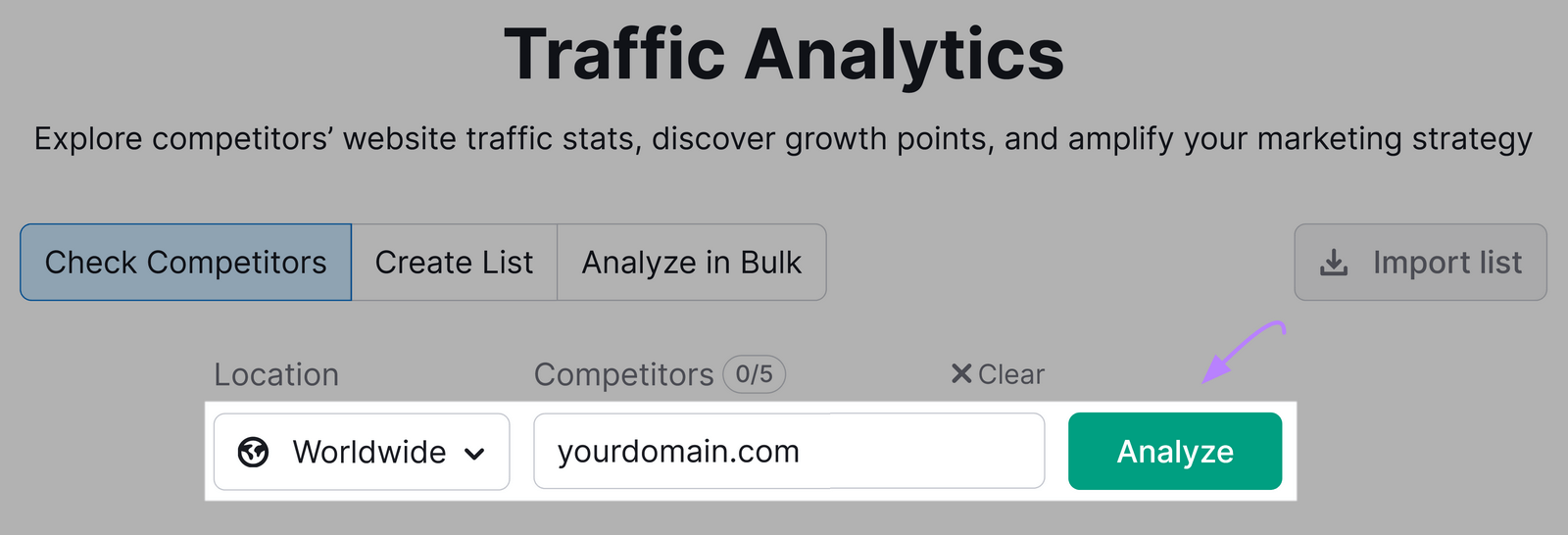
Furthermore, enhance the competitive analysis by including up to four competitors’ URLs and selecting “Compare.” This step allows for a more detailed examination of key metrics, helping you identify opportunities and refine your strategy.
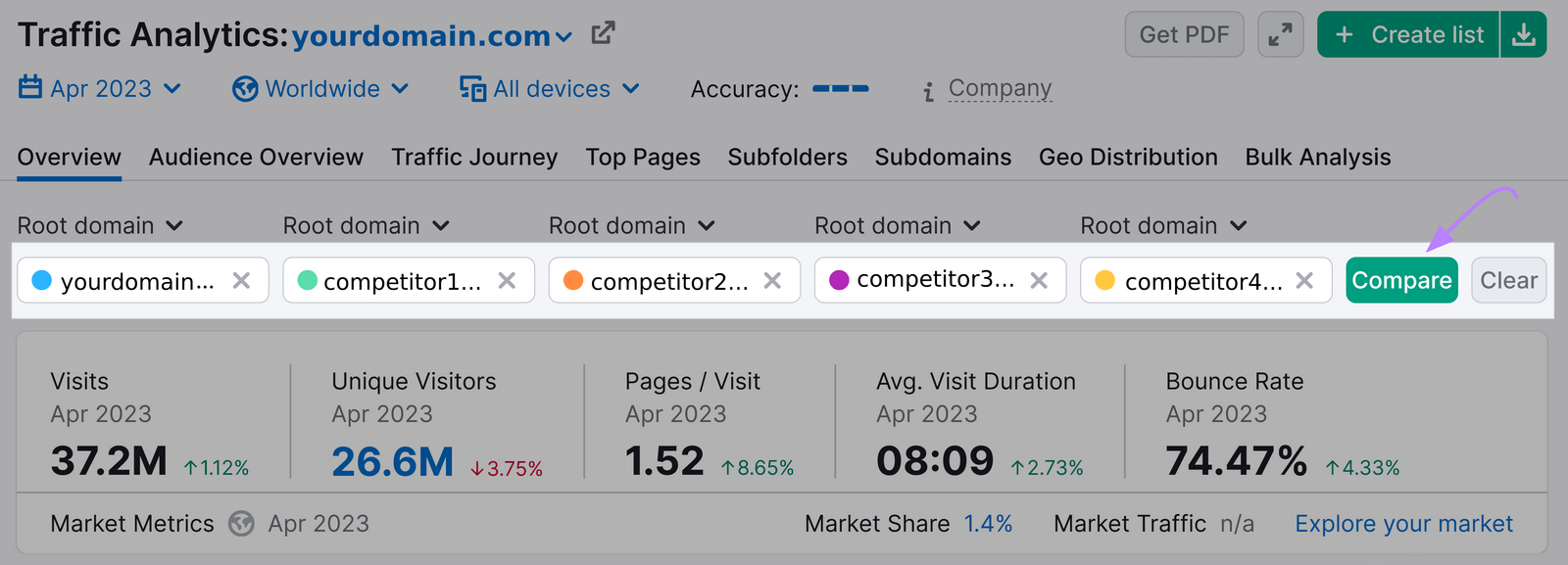
Evaluate the website’s performance across various metrics, including total visits and traffic sources such as direct, referral, paid social, and organic search. This comprehensive analysis provides insights into the strengths and weaknesses of the website’s online presence, aiding strategic adjustments for optimal results.
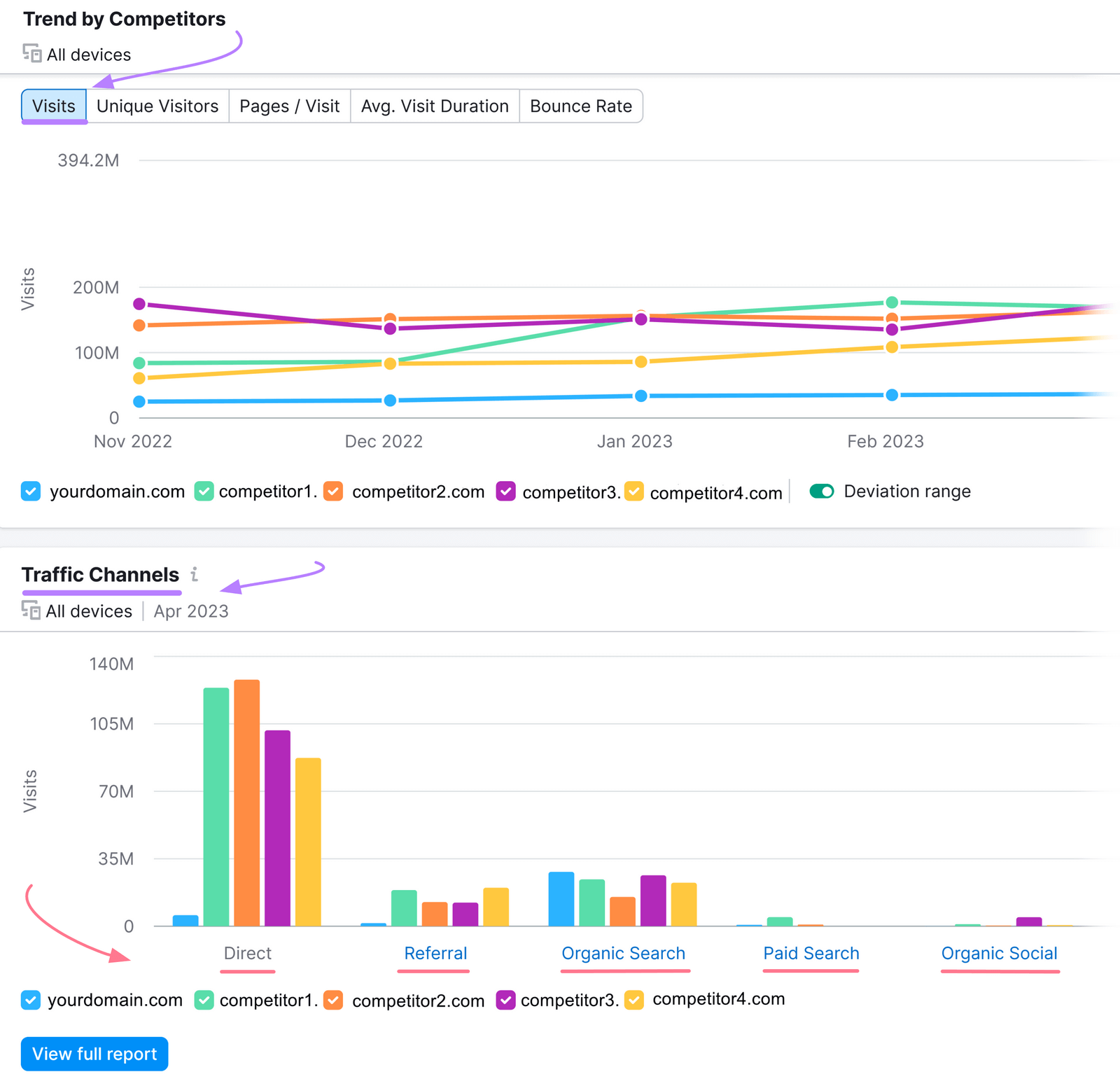
Explore the traffic journey view to identify the sources of incoming traffic and track its subsequent path after leaving your site. This valuable insight not only reveals the origin of its traffic but also aids in recognizing potential competitors in its online landscape.
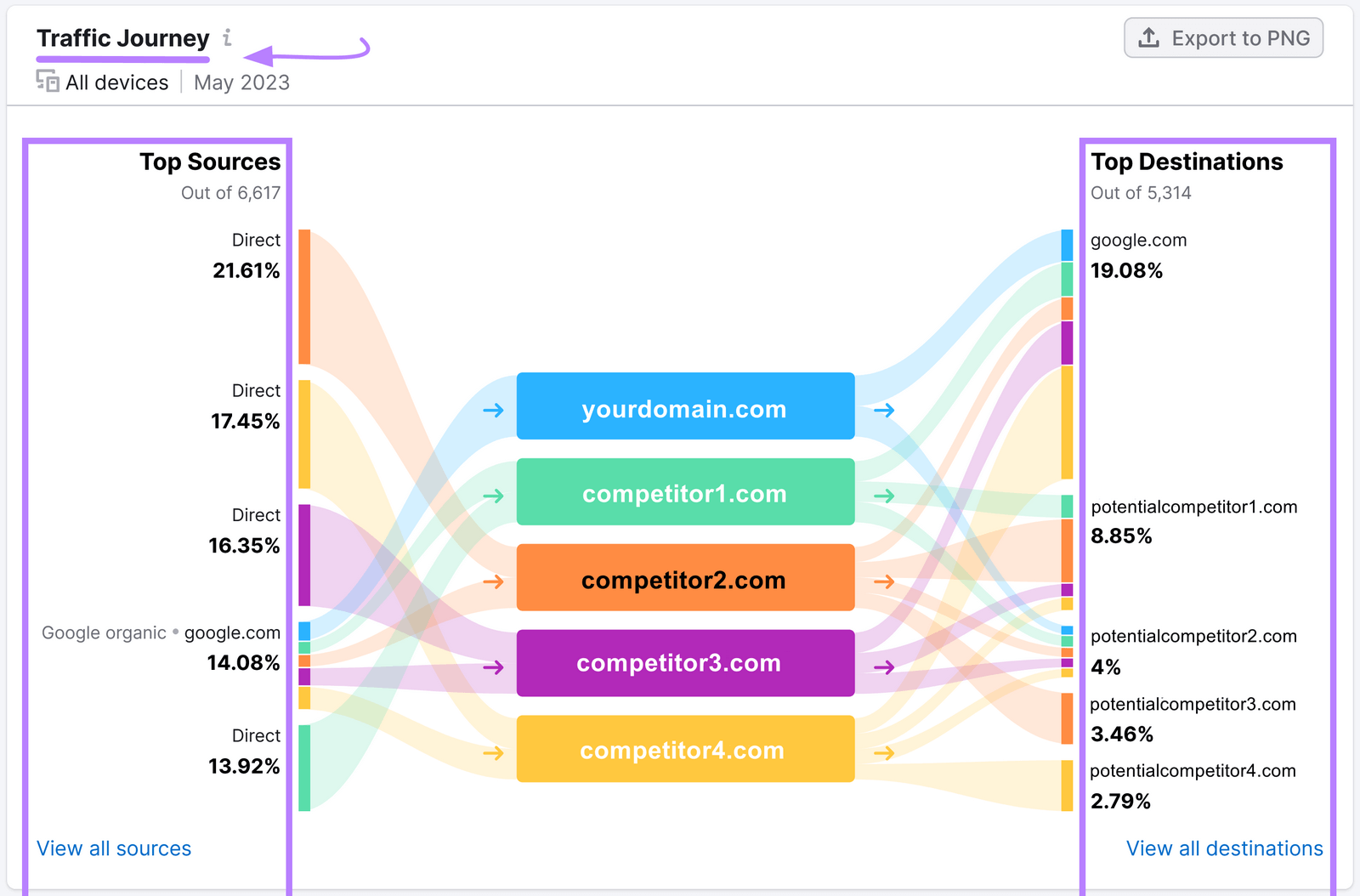
2. Keyword Rankings
Monitoring SEO rankings is crucial, as a drop in positions can lead to a loss of traffic and potentially harm your client’s business. Setting up a campaign using the Position Tracking tool allows you to monitor your rankings daily and automatically.
Simply enter the domain and click “Set up tracking” to initiate the process.
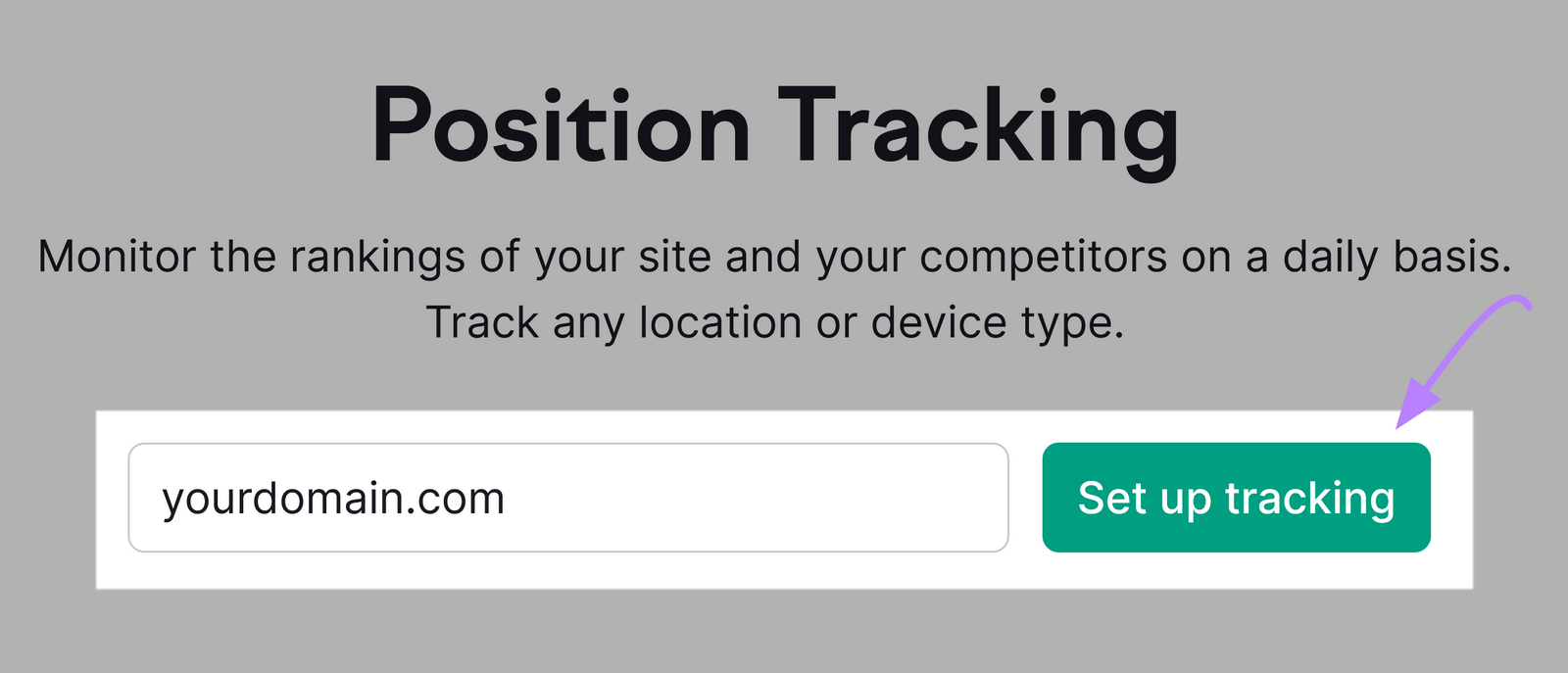
When initiating keyword ranking tracking, choose the domain type (e.g., “Root domain”), and specify search engine, device, location, and language preferences. This customization ensures accurate and relevant data for your SEO goals and target audience.
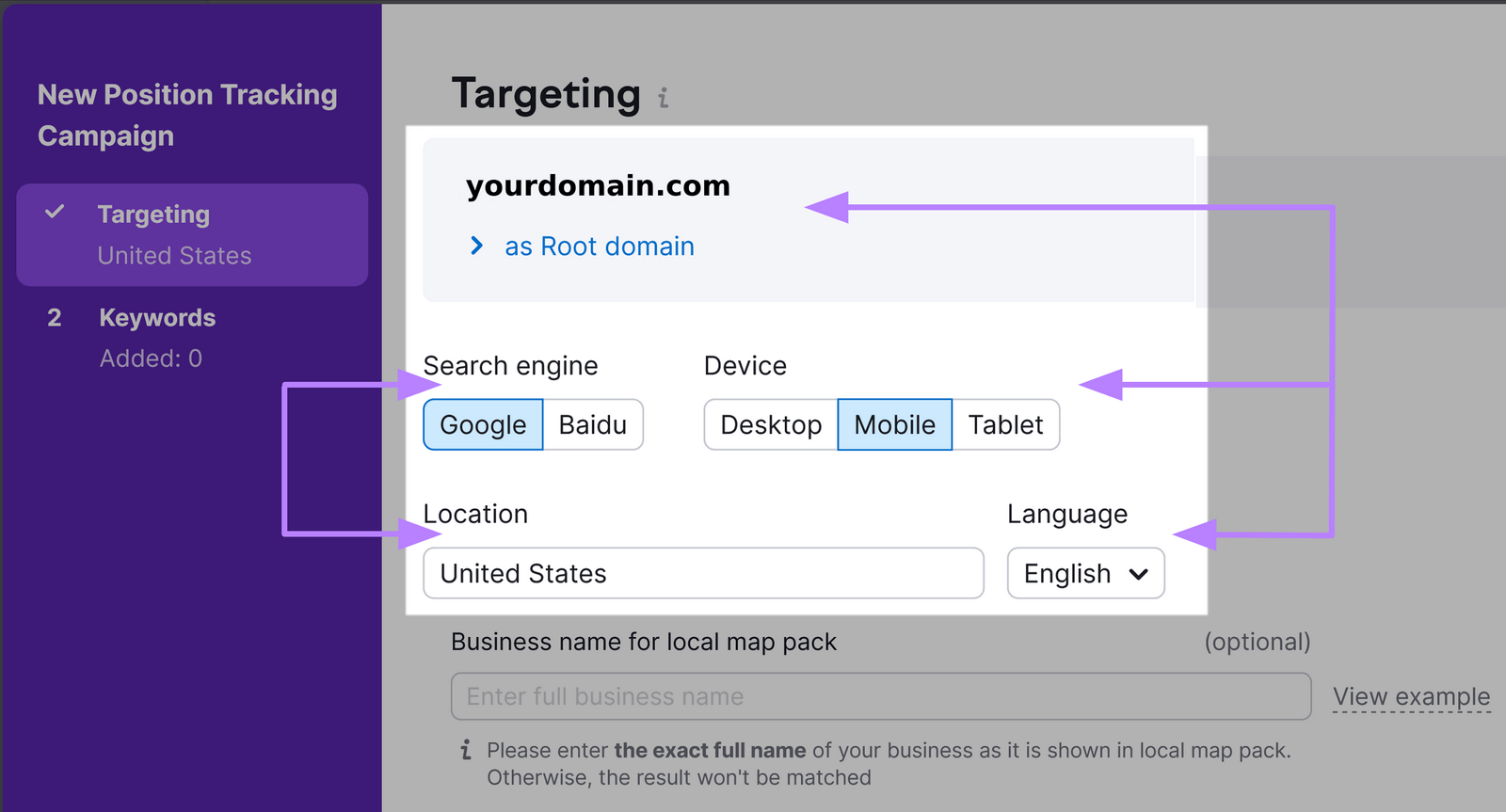
Once you’re done, click “Continue To Keywords.”
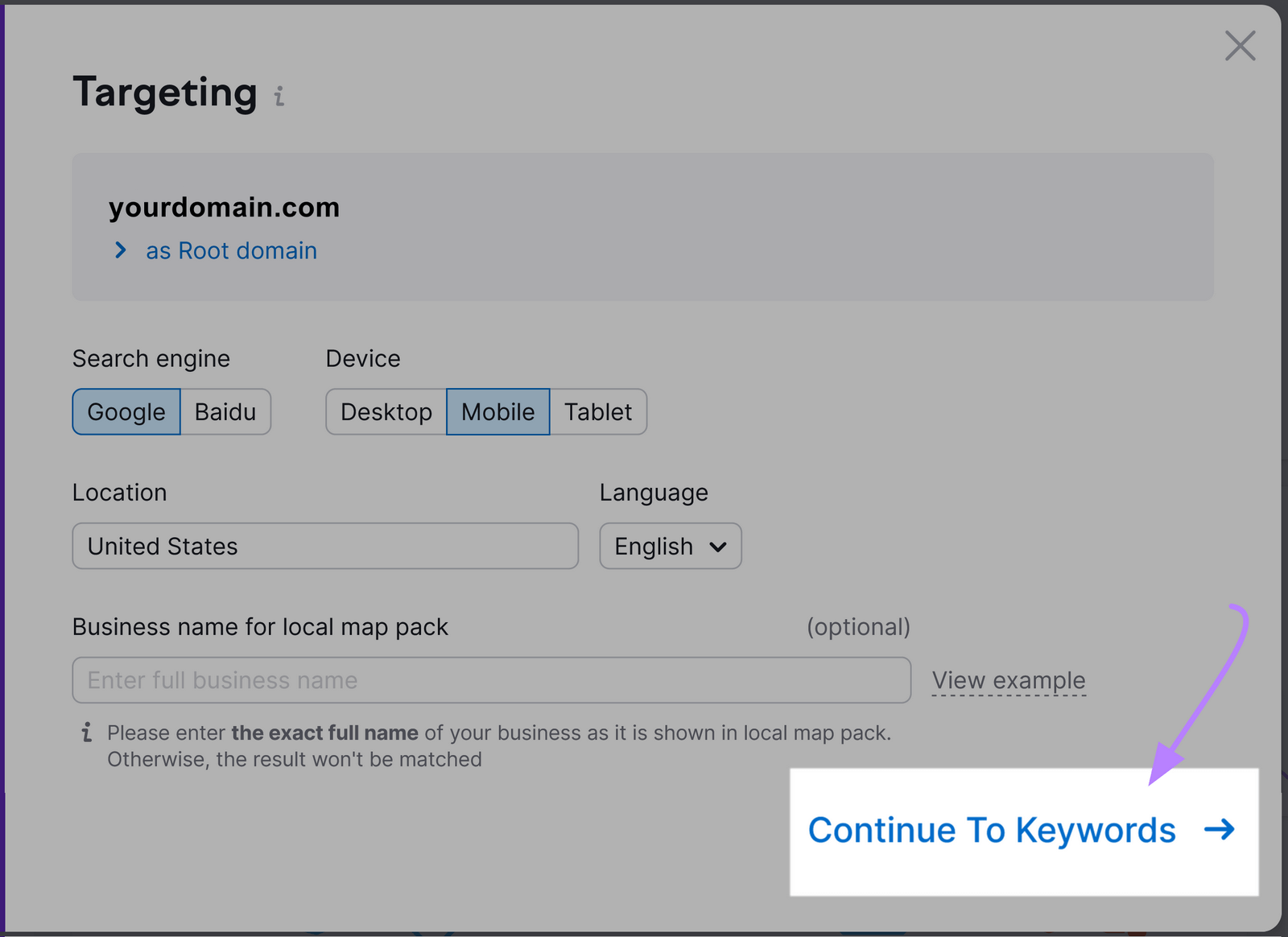
When setting up keyword tracking, input your chosen keywords manually or import a list from existing resources such as CSV files or previous campaigns. This step ensures precise monitoring of the specific keywords relevant to your SEO strategy.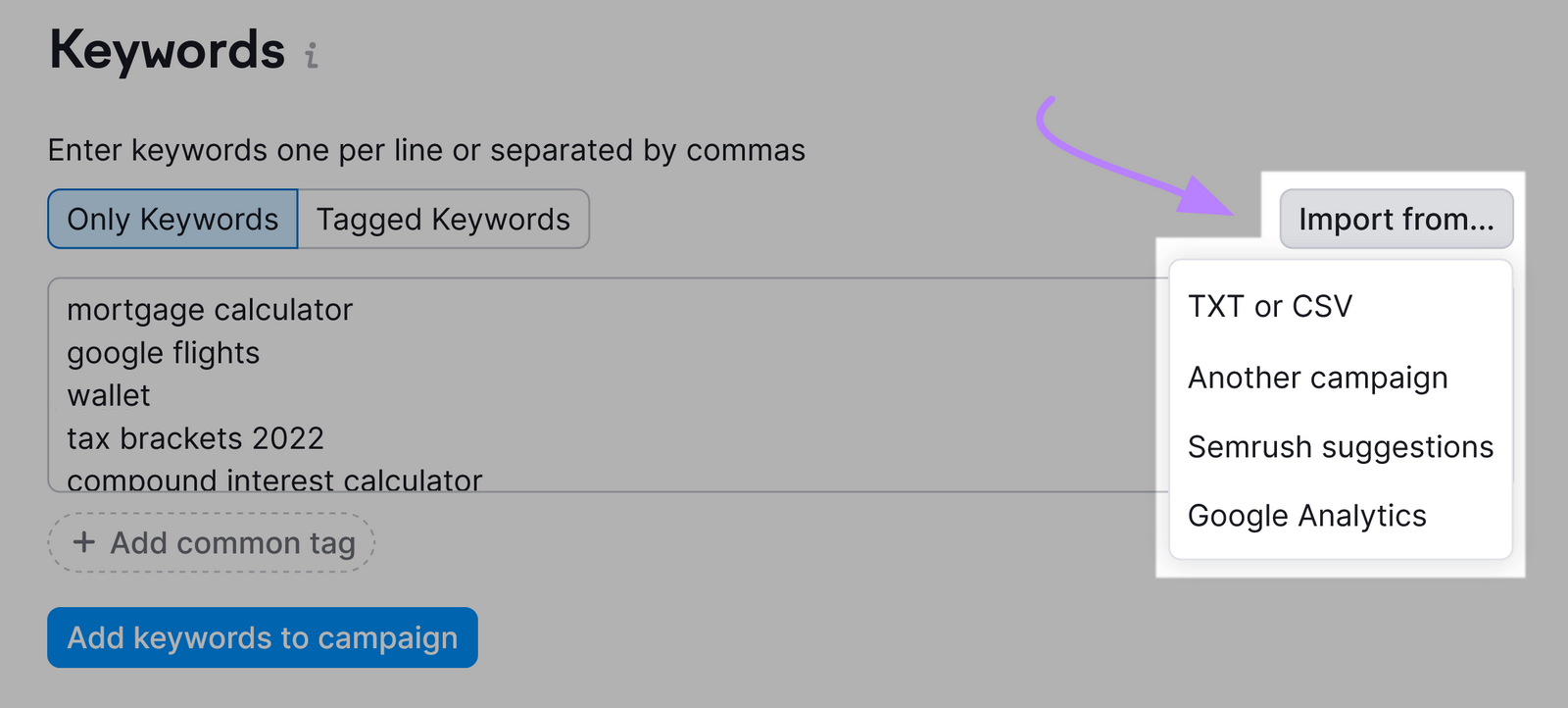
If you haven’t added any keywords, the tool will suggest important ones for tracking. Simply click “Start Tracking” to initiate the monitoring process.
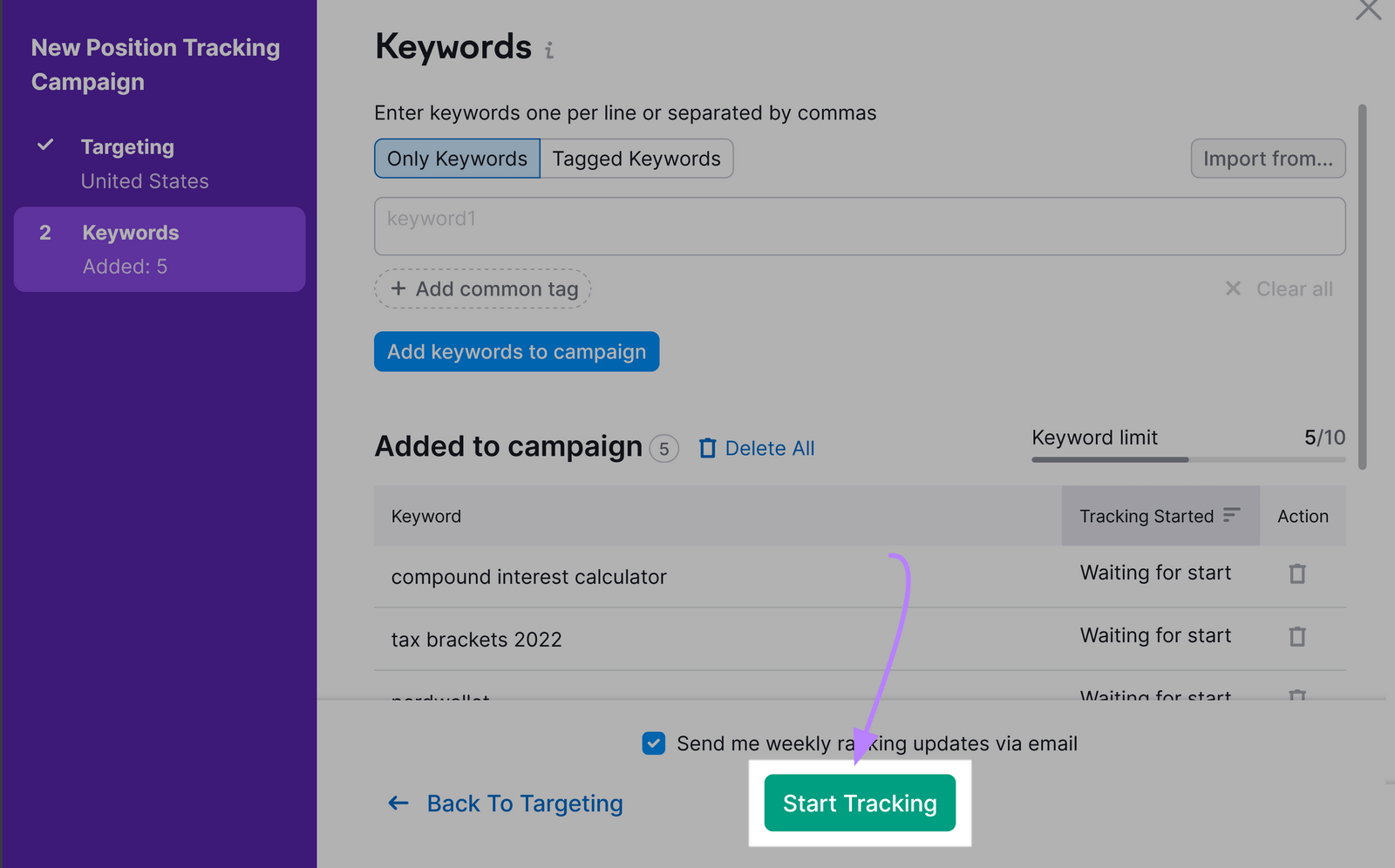
After the setup, the rankings will be displayed on the dashboard, giving you a clear overview.
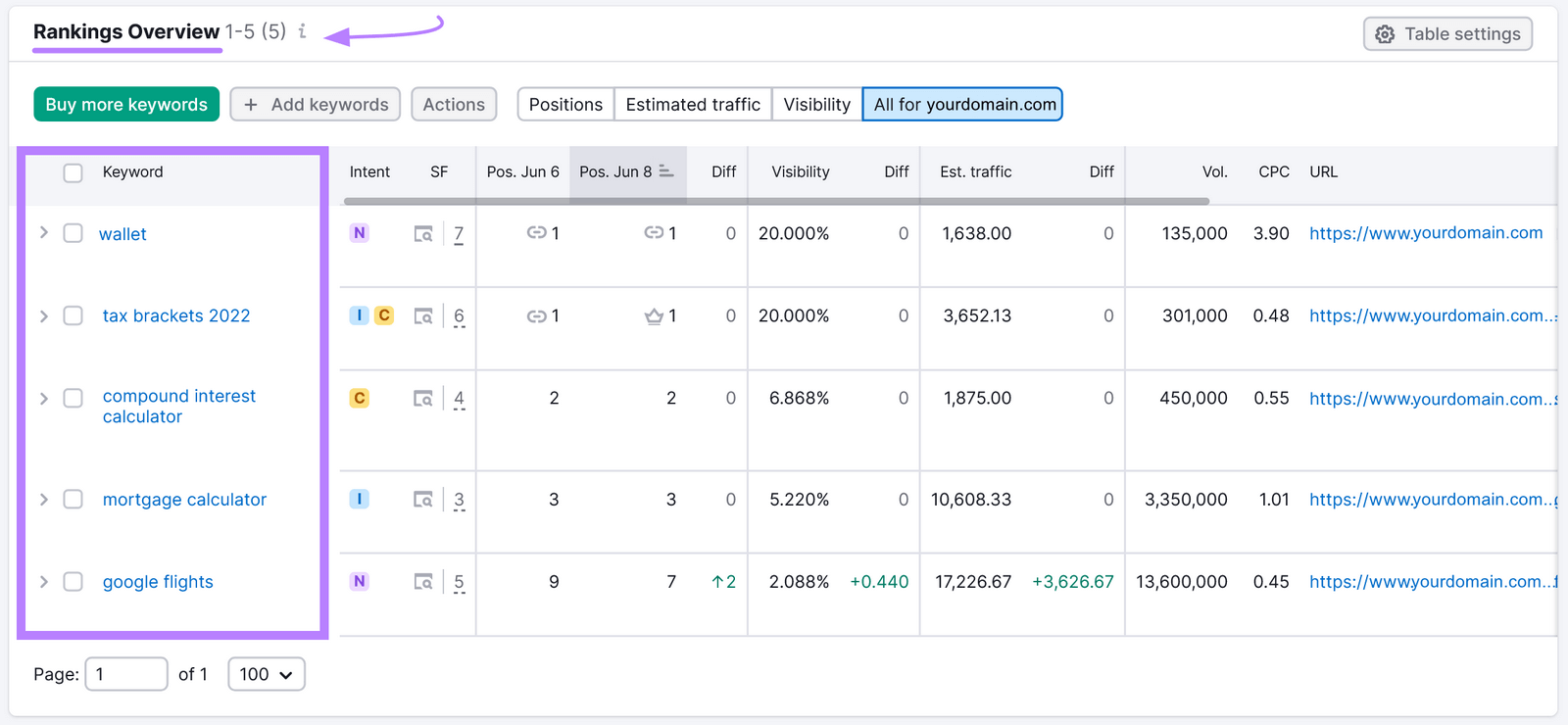
To gain deeper insights into your performance and uncover new keywords, perform a keyword gap analysis using the Keyword Gap tool. This will unveil the keywords that your competitors are ranking for, but you are not.
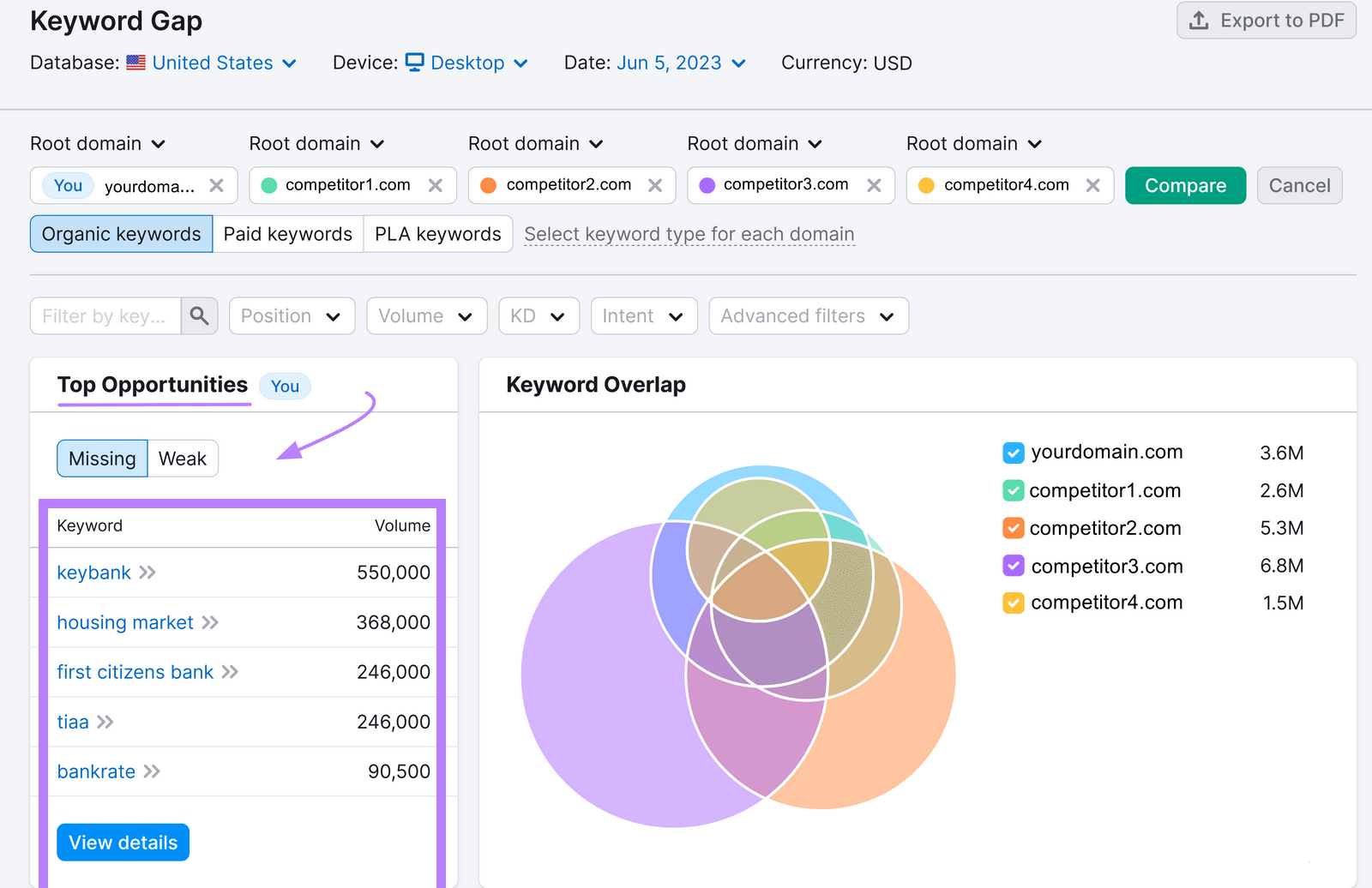
Every one of those keywords presents an opportunity to increase your website traffic.
3. Conversion Rate
Calculating SEO conversion rates involves defining a specific action, dividing the users who took that action by the overall site visitors, and multiplying the result by 100 to get a percentage.
This process helps you understand the value of each website visit.
For instance, if your thinkific seo site has a 4% conversion rate and an average purchase of $100, every 100 visits generate about $400. This means that each visit contributes an average of $4, aiding in tracking return on investment and projecting potential revenue from increased site traffic.
SEO Sprint with the Automate SEO

This time, want to make things easier?
Imagine turbocharging your SEO sprints with a one-click AI assistant. Automate SEO takes over and streamlining your sprints from start to finish.
- Just drop your URL and watch the magic happen:
- Analyze the competition: Automate SEO scans top search results, identifying ranking leaders and their backlink strategies.
- Uncover parasite hosts: Discover hidden opportunities to piggyback on your niche’s high-authority sites.
- Build partnerships on autopilot: Automate SEO crafts personalized emails, reaches out to potential hosts, and follows up until deals are secured.
All this in a single click, freeing you to focus on the strategic side of your sprints.
Forget tedious research and outreach – Automate SEO lets you sprint smarter, not harder.
Ready to supercharge your SEO game? Give Automate SEO a try and see your sprints reach new heights!
Unlock Business Growth with SEO Sprints!

One final crucial point to note – The SEO sprint as turbo boosts for business performance, going beyond just providing services and making a real impact.
If you’re guiding clients on adopting your SEO sprints model, consider these reasons why they should embrace this approach:
1. Budget-Friendly Boost

These targeted, short-term projects deliver faster results (think weeks, not months) at a fraction of the cost of traditional SEO campaigns.
Think of it like:
- A quick traffic boost: Get their website noticed without breaking the bank.
- A focused push: Target specific goals like launching a new product or ranking for seasonal keywords.
- A one-time investment: No long-term contracts or ongoing fees, just results.
Bonus: A successful SEO sprint not only impresses stakeholders but also builds trust for potential upsells. This is worth promoting for businesses on a tight budget looking for quick SEO gains.
2. Time-Sensitive Solutions

Freshly launched startups, small businesses, and event marketers often need quick SEO boosts for product launches or short-term campaigns. Traditional SEO takes too long.
That’s where sprints come in. These targeted bursts deliver faster results (think weeks, not months) at a focused cost.
3. Easier product packaging

Sprints are like pre-built plans with clear goals and fixed prices. No more deciphering confusing packages or wondering what’s included. Choose the sprint that fits your client’s needs and budget, and SEO Sprints will handle the rest. It’s that simple!
4. Recurring Revenue Engine

Sprints are adaptable! Clients can choose stand-alone sprints for targeted goals or ongoing sprint plans for sustained growth. It’s their journey, and they can choose the pace that suits the best.
5. Strategic Focus & Efficiency

Sprints embrace this with flexible, goal-oriented plans tailored to each business’ needs and market landscape. Instead of a one-size-fits-all approach, each sprint becomes a focused chapter, driving tangible progress towards pre-defined objectives.
6. Repeatable processes

It’s a common struggle: balancing basic SEO principles with unique client’s needs and goals. Sprints offer a solution! By focusing on short-term, targeted goals, they create a repeatable blueprint you can adapt for diverse situations. Imagine streamlined processes, consistent results, and happy clients – that’s the sprint magic!
7. Niche Expertise & Standing Out

Satisfied clients, inspired by the success of the SEO sprint, naturally become advocates. For example, when individuals search for services such as SEO for wedding photographers, architect SEO, financial planner SEO, virtual assistant SEO, or any other SEO services you offer, your page gains visibility. This organic word-of-mouth generates valuable referrals within their networks, enhancing your reputation and fostering additional client acquisition, whether online or offline.
Looking for SEO Dominators Club? Explore our guide tailored for SEO enthusiasts like yourself.
SEO Sprints Secrets Unlocked!

After all, it’s not magic, it’s strategy.
In steering your SEO teams, SEO sprints offer a strategic advantage. Delve into their potential, simplified processes, and uncovered pro secrets. From mastering the basics to adopting the best and easiest way- SEO automation software, seize the keys to streamlined success.
Bid farewell to uncertainties – SEO sprint model offer a systematic approach that operates seamlessly.
Ready to bid adieu to chaos and usher in organized triumphs in your SEO endeavors?
Let’s plunge into the world of SEO sprints and reshape your SEO journey for unparalleled success.
The resolve is clear: let SEO Sprints be your key to unlocking sustained growth and unwavering digital excellence.
One More Thing
Let’s Conquer the Online Battlefield ⚔️
Free Knowledge Vault: Subscribe to Profitable Growth on YouTube. Insider tips, explosive strategies, business growth secrets.
Personalized Guidance: ⚡️Connect with me on LinkedIn. Limited coaching spots left! Supercharge your business with laser-focused expertise.
Outsmart, not crush, your competition. Build a sustainable, profitable business. Let’s thrive!
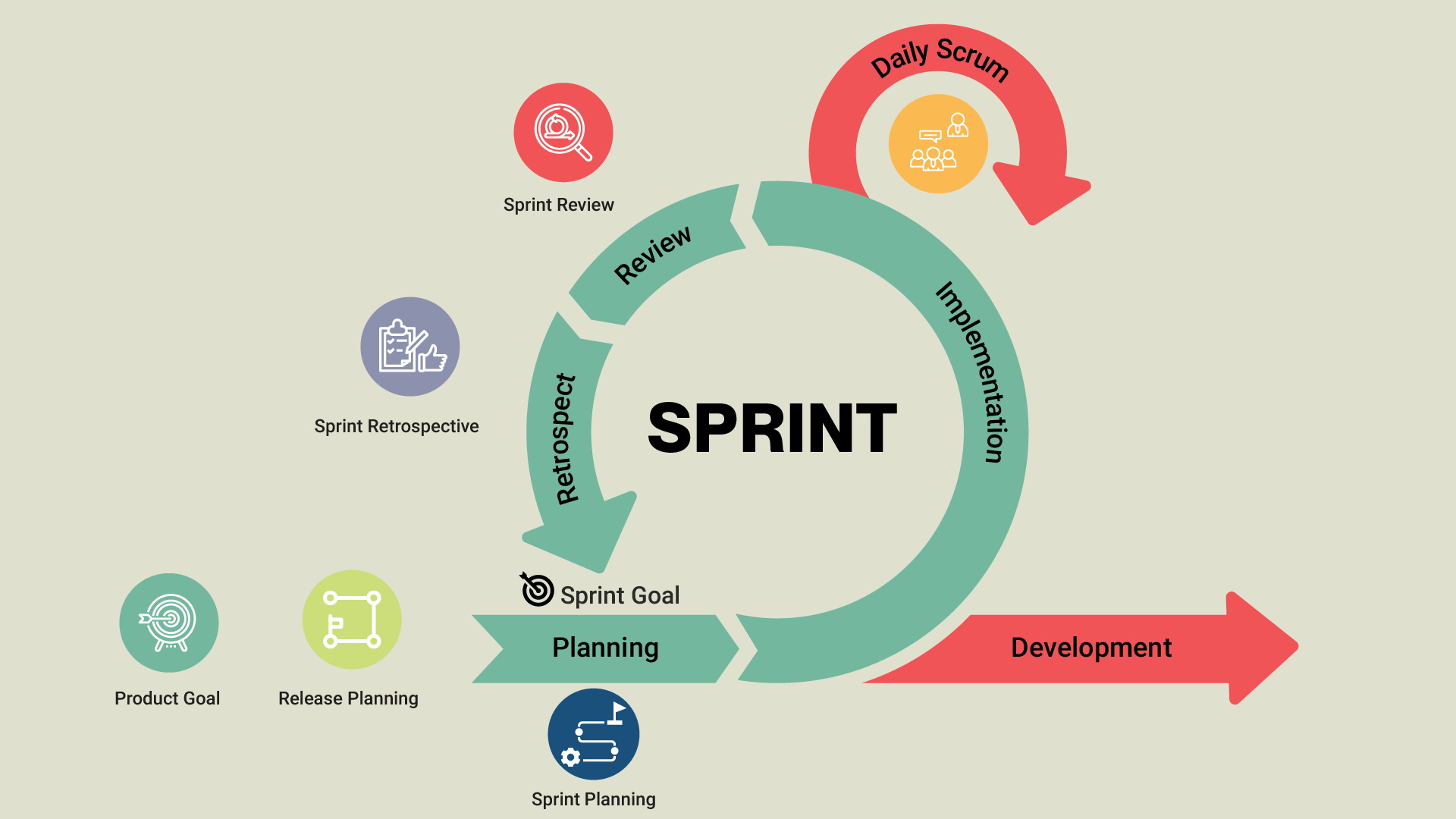
Leave a Reply